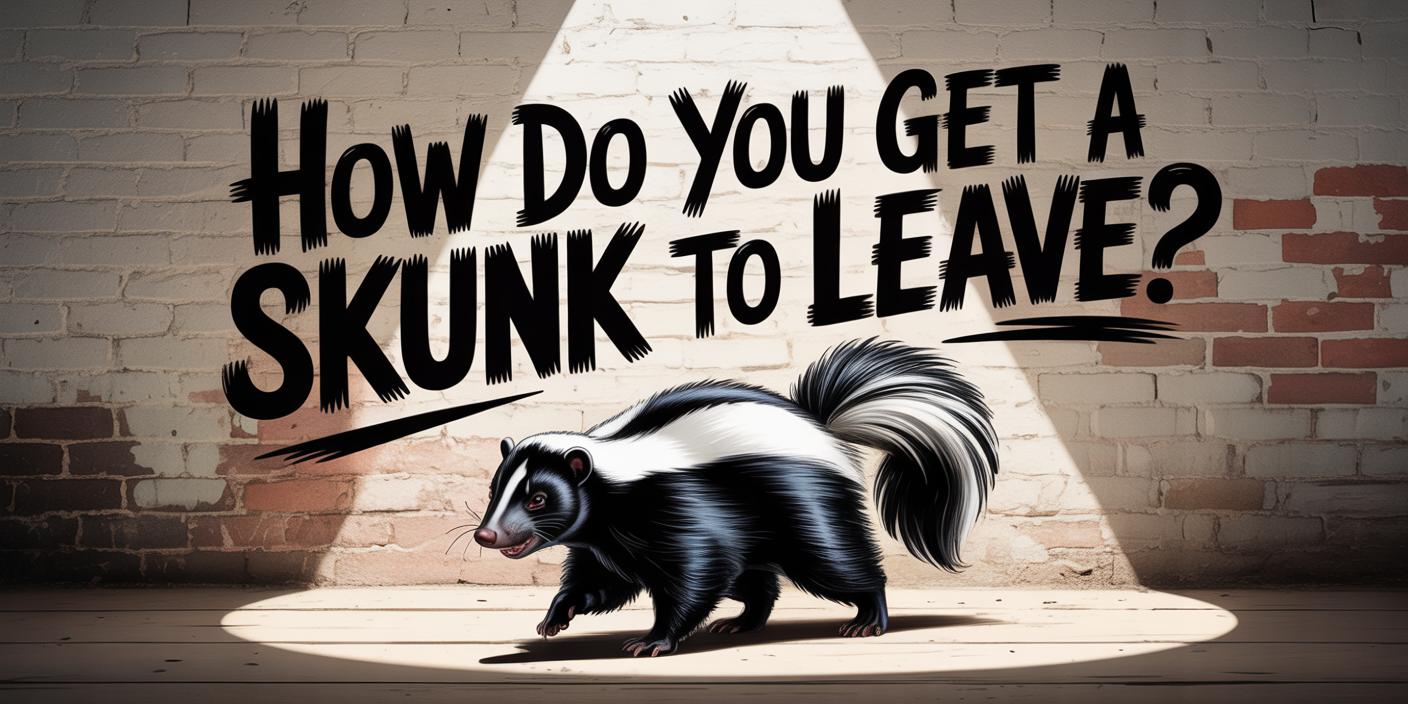Seal entry points and use bright lights, noise, or natural repellents like ammonia. If the skunk stays, contact a professional for humane removal.
Skunks are often the last wildlife visitors we want on our property. Their unmistakable scent, nocturnal habits, and tendency to make themselves at home under decks, sheds, or in attics can quickly turn a peaceful space into a smelly nightmare. While they might seem harmless, skunks pose significant risks to your home, your pets, and even your health.
From causing damage to insulation and wiring, to potentially carrying diseases like rabies or leptospirosis, it’s clear that getting a skunk to leave your property is more than just a matter of odor, it’s a necessity for both your safety and peace of mind.
But how do you get a skunk to leave without resorting to harmful methods or pushing it into a corner? In this guide, we’ll walk you through humane, expert-approved strategies that will help you safely encourage these pesky creatures to vacate your space, all while avoiding the common traps of generic, ineffective advice. Ready to regain control of your home? Let’s get started.
Understanding Skunk Behavior: Why Are They Hanging Around?
Before you can effectively encourage a skunk to leave, it’s important to understand why they chose your home in the first place. Skunks aren’t looking to invade your space out of malice, they’re simply trying to meet their basic needs. Here are some typical reasons why skunks make themselves at home on your property:
- Seeking Shelter: Skunks are opportunistic creatures and will find warm, secluded spaces to burrow, especially in colder months. Attics, basements, and crawl spaces offer ideal hiding spots where they feel safe from predators and the elements.
- Food Sources: If your property provides easy access to food, whether it’s unsecured trash cans, fallen fruit from trees, or pet food left outside, you might as well be sending an invitation. Skunks are omnivores and will gladly scavenge for whatever they can find.
- Access to Water: Like all animals, skunks need water to survive. If your property has standing water from leaky pipes, birdbaths, or even pools, it may attract skunks looking for a drink or a cool place to relax.
- Attractive Landscaping: Overgrown bushes, tall grass, and dense shrubs provide perfect cover for skunks to nest or move about unnoticed. If your landscaping offers hiding spots or places to dig, skunks will often settle in.
- Breeding or Nesting Needs: Female skunks, especially in spring, look for quiet, secure places to raise their young. If your property offers the right conditions, you might find a mother skunk making a den underneath your deck or shed.
By understanding why skunks are attracted to your property, you can take more targeted actions to address their needs and effectively encourage them to leave.
Step-by-Step Guide to Getting a Skunk to Leave
When it comes to skunk removal, the key is to act quickly and strategically. By following these steps, you’ll be taking the necessary precautions to safely and humanely encourage a skunk to leave your property, without resorting to harmful traps or repellents. Here’s how to do it:
Step 1: Identify and Seal Entry Points
- Inspect Your Property: Start by carefully inspecting your home for potential entry points. Skunks are skilled at squeezing into small, hidden spaces, so check crawl spaces, basements, attics, and any other openings around the foundation. Look for gaps or holes that are larger than 2 inches wide, as skunks can fit through surprisingly small spaces.
- Seal Off Access: Once you’ve identified entry points, use durable materials like hardware cloth, wire mesh, or caulking to seal them. Be sure to cover any holes or cracks securely, but leave the entry point open for a few days. This gives the skunk a chance to leave on its own before you seal it off for good.
- Tip: Be cautious, don’t trap the skunk inside, as this will only make matters worse.
Step 2: Make the Environment Unwelcoming (Without Hurting the Skunk)
- Use Bright Lights and Noise: Skunks are nocturnal and prefer dark, quiet spaces to rest. To make your property less inviting, place bright lights around areas where the skunk has been active (motion-sensor lights work best). Additionally, using a radio or a loud noise generator can encourage the skunk to leave, as they’re sensitive to sound.
- Position Lights and Sounds Strategically: Place these noise-making devices or lights near potential entry points or skunk hotspots, such as under decks or near sheds. This creates an uncomfortable environment for the skunk, encouraging it to find a more peaceful retreat elsewhere.
Step 3: Use Safe and Natural Repellents
- Use Ammonia or Predator Urine: Skunks tend to avoid areas marked by predators. To take advantage of this, use ammonia-soaked rags or commercially available predator urine (coyote or fox urine) to create an area the skunk finds too threatening to stay in.
- Apply Repellents Effectively: Place these rags or urine-soaked materials near the entry points or in areas where the skunk has been active. Be sure to reapply as needed, especially after rain. These natural repellents signal to the skunk that this is not a safe place to stay.
Step 4: Call in the Experts if Needed
- If the skunk refuses to leave despite your efforts, or if you find yourself unsure of how to proceed, it’s time to call a professional wildlife removal service. Experts like AAAC Wildlife Removal have the right tools, experience, and knowledge to remove the skunk safely and humanely, without causing harm to the animal or risking injury to yourself.
- Don’t wait too long, skunks can carry diseases, and the longer they stay, the more difficult it can become to remove them.
Preventing Future Skunk Encounters: Long-Term Solutions
Once you’ve successfully encouraged a skunk to leave, the next step is ensuring it doesn’t come back. Preventing future skunk encounters requires a proactive approach to securing your property and eliminating the conditions that attract them. Here’s how to keep your home skunk-free for the long term:
Step 1: Secure Trash and Food Sources
- Store Trash in Secure Containers: Skunks are scavengers, and unsecured trash cans are a major draw. To prevent skunks from returning, make sure all garbage is stored in tightly sealed containers. Consider investing in trash bins with locking lids to make it difficult for skunks to access food scraps.
- Remove Outdoor Food Sources: Never leave pet food, birdseed, or fallen fruit from trees outside overnight. These provide a free meal for skunks and other wildlife. Additionally, clean up any spilled food or seeds regularly to avoid attracting them in the first place.
Step 2: Seal All Entry Points
- Inspect Your Property Regularly: It’s essential to regularly check for any new gaps or holes that could serve as an entry point for skunks. As part of a routine maintenance schedule, inspect your home’s foundation, roof, and exterior for cracks and gaps that skunks can slip through.
- Fortify Weak Spots: If you find any vulnerable spots, seal them up immediately using materials like heavy-duty mesh, steel wool, or reinforced concrete. Pay particular attention to areas around vents, pipes, and chimneys, common entry points that skunks often exploit.
Step 3: Modify Landscaping to Deter Skunks
- Trim Overgrown Vegetation: Skunks thrive in overgrown areas that provide shelter and a place to dig. Keep bushes, shrubs, and tall grass trimmed back to eliminate hiding spots around your home. This will make your property less inviting to skunks looking for a place to nest.
- Use Natural Barriers: Planting certain plants, such as daffodils, lavender, or marigolds, can act as natural deterrents, as skunks tend to avoid strong-smelling plants. Consider adding these to your garden as a natural way to repel skunks while enhancing your outdoor space.
Step 4: Maintain a Skunk-Proof Yard
- Close Off Sheds, Decks, and Other Hiding Spots: Skunks love to den under sheds, decks, and other structures. To prevent skunks from nesting on your property, ensure that these areas are properly sealed with mesh or boards. Installing skirting around decks and sheds can also keep skunks from burrowing underneath.
- Install Motion-Sensor Lighting: Since skunks are nocturnal, they prefer dark, undisturbed spaces. Installing motion-sensor lights around your property can make it less attractive to skunks. These lights will disrupt their nighttime activities and encourage them to seek shelter elsewhere.
Step 5: Consider Professional Maintenance and Monitoring
- Schedule Regular Inspections: Even after taking all necessary preventive measures, it’s wise to schedule annual inspections from a wildlife control expert. This ensures that any new entry points are identified early and that your property remains secure.
- Implement Ongoing Wildlife Management: Consider setting up a wildlife management plan with a professional service like AAAC Wildlife Removal. Regular monitoring and preventive measures will help maintain a skunk-free environment and address potential problems before they escalate.
Skunk-Free and Safe, What’s Next?
Dealing with skunks can be a frustrating experience, but with the right knowledge and approach, you can remove them safely and prevent future encounters. By understanding skunk behavior, using humane removal methods, and taking steps to secure your property, you’ll create an environment that’s unappealing to these pesky creatures. The key to long-term success lies in proactive prevention, sealing entry points, securing food sources, and maintaining a skunk-proof yard are essential steps in keeping your home skunk-free.
If you’ve tried everything and the skunk won’t budge, don’t hesitate to call in the experts. AAAC Wildlife Removal specializes in humane, effective wildlife control that ensures the safety of both your family and the animal. With the right help, you can rest easy knowing your home is safe from skunk invasions.
Ready to get your home skunk-free? Contact AAAC Wildlife Removal today and let us handle the problem with expertise, care, and the best solutions for your situation.
Need Help with Skunk Removal?
Don’t let skunks take over your home. If you’re dealing with a skunk infestation or just want to ensure your property stays protected from future wildlife problems, AAAC Wildlife Removal is here to help. Our team of experts uses humane, professional methods to safely remove skunks and prevent them from coming back. Get in touch today for a consultation and let us keep your home safe and skunk-free!




